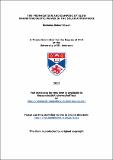The propagation and damping of slow magnetoacoustic waves in the solar atmosphere
Abstract
The propagation and damping of slow magnetoacoustic waves in the solar atmosphere is investigated, with
particular emphasis placed on waves with periodicities of five minutes. The basic model of a uniform
temperature loop is extended by the addition of an equilibrium temperature gradient allowing study of
wave propagation from the transition region to the corona. The inclusion of thermal conduction produces
a phase shift between the perturbations in velocity, density and temperature, which for a non-uniform
equilibrium temperature varies along the loop and may be observable as a phase shift between intensity and
Doppler shift observations. Forward modelling of the simulation results, for both constant and non-constant
equilibrium temperature profiles, is undertaken in order to establish the observational consequences for
TRACE, SoHO/CDS and Hinode/EIS. Slow waves propagating in a non-uniform equilibrium temperature
loop are seen to damp rapidly in the corona, however, as a result of the ionisation balance, the inclusion of
damping can actually increase the amplitude of some parts of the oscillation.
The ability of several data analysis techniques to identify oscillation signatures are examined. In particular,
empirical mode decomposition was found to be a very useful technique for extracting oscillations from a
wide range of data sets and is capable of intrinsically determining background trends. Co-spatial and cotemporal
TRACE 171 A, CDS and EIS data are analysed for evidence of propagating slow waves. Slow
waves with periods of 210 s to 370 s are found with amplitudes of 1.2% to 3.4% in the corona and 2.3% to
6.0% in the transition region.
Type
Thesis, PhD Doctor of Philosophy
Collections
Items in the St Andrews Research Repository are protected by copyright, with all rights reserved, unless otherwise indicated.

